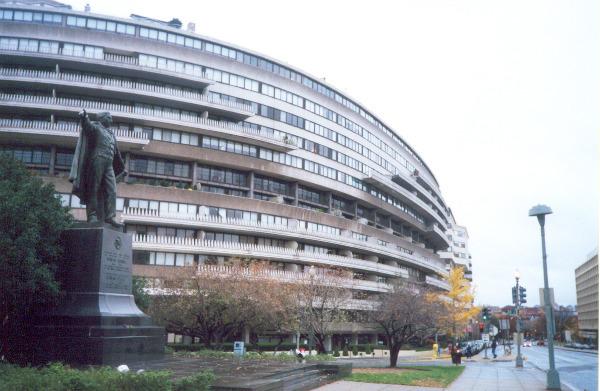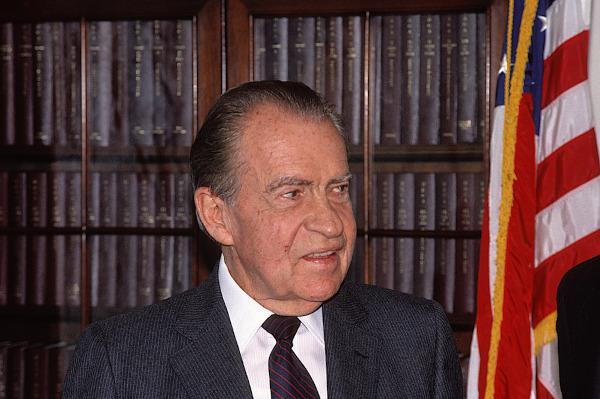Richard Nixon was an American politician, affiliated with the Republican Party, and elected 37th President of U.S, ruling from 1969 to 1972, and re-elected for a second term, which ended in 1974, shortly after his resignation on account of the complaints in the Watergate case. Nixon majored in law and served in the US Navy during the Second World War.
He started his political career in 1946, being elected deputy and senator. He was vice president in the Eisenhower government between 1953 and 1961. Nixon ran for president of the United States in 1960, but was defeated by Democrat John Kennedy. Shortly after his resignation, Nixon received a pardon from President George Ford and walked away from politics. He died in 1994, aged 81, after suffering a stroke.
Read too: What are the states of the United States?
Richard Nixon's Early Years and Youth
Richard Milhous Nixon was born on January 9, 1913, in the city of Yorba Linda, in the state of California, west coast of the United States. His parents, Hannan Milhous Nixon and Francis A. Nixon, were practitioners of the Quaker, a Protestant Christian religion of British origin.
His family faced financial difficulties, and Nixon's childhood was marked by lung problems, which prevented him from playing sports.His first years of study were at Whittier College, and his secondary at Union Fullerton School. At this time of high school, Nixon showed-ifa student leader and talented debater, being recognized by his teachers because of his oratory. In 1934, Nixon received a scholarship to attend dlaw at Duke University, and, in 1937, he graduated as the third best student in his class.
Nixon married Pat Ryan in 1940, and the couple had two daughters: Tricia and Julie.
Do not stop now... There's more after the advertising ;)
Richard Nixon's Political and Military Career
With the United States' entry into World War II at the end of 1941, Nixon enlisted in the US Navy. Practitioner of the Quaker faith, he could ask for exemption from compulsory military service, but joined the navy by free will. His development was commendable, and by the following year he was named junior lieutenant in the navy reserve. Nixon served as a naval officer in the Asia.
Shortly after the end of the war, Nixon entered politics, through the Republican Party, and was elected a deputy and, shortly thereafter, a senator. He began to draw national attention in 1948, when he was on the House Anti-American Activities Committee. Nixon investigated the Alger Hiss spy case, accused of being soviet spy. In the Senate, he also maintained the anti-communist speech and criticized President Henry Truman's performance in the Korean War.
For the 1952 presidential elections, the Republicans nominated General Dwight D. Eisenhower for President and Richard Nixon for vice. The ticket came out victorious and Eisenhower took office the following year. The new republican president gave space for the vice, Nixon, to act in the government and in the North American foreign relations.
In 1960, Americans went to the polls to choose their new president. Two candidates competed for the White House: Democrat John Kennedy and Republican Richard Nixon. This dispute was marked by television debates. In one of these debates, Nixon appeared on television very nervous, sweating profusely, while Kennedy was in good spirits and very comfortable in front of the cameras. However, those who heard the debate over the radio acknowledged that Nixon managed to express himself better than Kennedy. The result was the victory of the Democrat.
After the defeat in the presidential election, Nixon returned to California, where he resumed his work as a lawyer. In 1962, he decided to return to politics and he ran for government in his home state, but lost the election to Pat Brown. The press called the defeat the end of Nixon's political career. Recognizing the strength of John Kennedy and, after his assassination, Lyndon Johnson, Nixon declined to run again to the presidency in the 1964 elections and decided to support the Republican candidate Barry Goldwater, who was defeated by Johnson.
In 1968, Nixon ran for president again, taking advantage of the wear of the Democrats in relation to the Vietnam War. During this period, the United States lived moments of instability caused by the protests against the war and the deaths of the black leader Martin Luther King and Democratic pre-candidate Robert Kennedy. Nixon won the Republican Party nomination and became a presidential candidate again. On the Democratic side, Hubert Humphrey, vice president, was chosen.
During the campaign, Nixon tried to show the American voter that he was a moderate leader capable of running the country in these uncertain times and social mobilizations. His campaign was based on his promise to close the Vietnam War, ensuring peace in the Pacific, and criticizing the crime rate. Nixon defeated Humphrey and was elected the 37th president of the United States.
See too: What were the founding fathers of the United States?
Richard Nixon in the presidency
After two Democratic terms, Republicans returned to the White House. Richard Nixon was sworn in as president on January 20, 1969. In his inaugural address, the new president kept his promise to be a peacemaker and end the conflict in Vietnam. Peaceful protests continued in the United States, and Nixon was willing to end the war as soon as possible. Months after his inauguration, he began peace talks with North Vietnam and the withdrawal of US troops. In Paris, an agreement was sought between the two parties.
![Richard Nixon was the 37th president of the United States between 1969 and 1974. [1]](/f/5e7dcf40bfe7642dca9addf271138fc3.jpg)
In July 1969, Nixon visited South Vietnam and promised the progressive withdrawal of troops, but he authorized military action against the North. Nixon's visit à Asia was marked by protests. The US press began publishing secret documents, leaked from the Pentagon, headquarters of the Department of Defense, on the lies that previous governments had published about the War of the Vietnam.
At first, Nixon didn't mind the release of these documents, but he was persuaded by advisers to ban the release. Triggered, the Supreme Court gave a favorable opinion to the journalists. These disclosures only increased criticism of the White House's conduct in Vietnam and pressure for the war to end immediately.
In 1971, the withdrawal of troops from Vietnam began.. Two years later, the Paris Agreement was signed, and the ceasefire allowed for the complete withdrawal of US troops and the end of the conflict that had killed so many soldiers. In 1975, North Vietnam conquered the South, and the country was unified.
Nixon sought to get closer to China led by Mao Tse-Tung. Henry Kissinger advised him on this approach and became Secretary of State. In the late 1960s, at the height of the Cold War, relations between China and Soviet Union were worn out and the cordiality between Americans and Chinese could be a blow to the Soviets. In February 1972, Nixon traveled to China and met Mao, and recognized Taiwan as part of China. The American press followed the trip, and Nixon insisted that the images captured his encounter with Chinese leaders.
Relations between the United States and Cuba became unstable in the Nixon administration. He had allies among exiled Cubans and intensified covert operations against Fidel Castro. However, the understanding of non-aggression between the two countries that began in 1962, right after the Missile Crisis, was maintained.
In Chile, in 1970, with the victory of Salvador Allende as president, who defended the application of theses Marxists, Nixon decided to act to destabilize the Chilean government by encouraging the opposition not to recognize Allende's election and funding strikers to demonstrate against the government. The September 11, 1973 coup, who deposed and assassinated the Chilean president, starting the dictatorship of General Augusto Pinochet, had the support of the White House.
After approaching China, Nixon strengthened relations with the Soviet Union regarding nuclear peacekeeping. Both superpowers had nuclear weapons, and an understanding was needed, even in times of the Cold War, to avoid a new world confrontation using highly destructive weapons. In 1972, Nixon landed in Moscow and sealed trade and arms control agreements. Two years later, he made another visit to the Soviet capital, showing the proximity between the two countries.

At the Middle East, the Nixon government increased arms sales to countries in the region and he defended that Israel make a peace agreement with the Arab countries, avoiding new conflicts. However, the tension between Jews and Arabs was permanent, and in 1973 the Yon-Kipur War began, which was won by Israel, which had US military support. After the war, Nixon sought to maintain diplomatic relations with the Middle East, and one of his last international visits as president of the United States was to that region.
The Vietnam War was at the center of the government's attention both in foreign policy and at home. Spending on the conflict generated protests and affected the economy through rising inflation. Nixon expanded blacks' access to public schools and their participation in government positions. He supported environmental policies by creating the Environmental Protection Agency. The government has stepped up the fight against drugs in the country.
In the space race against the Soviet Union, the United States won an important victory by reaching the Moon through the Apollo 11, in 1969. Nixon had a telephone conversation with the ship's crew. Despite this historic achievement, the president did not financially support NASA's projects to continue investing in trips to the moon and establishing a space station there. He decided to end the space race, started by John Kennedy in 1961 and deepened by Lyndon Johnson in the following years. In May 1972, Nixon approved a US-Soviet cooperative space program.
With the presidential election of 1972, Nixon was naturally the candidate for re-election by the Republican Party, against the Democrat George McGovern. Nixon was re-elected with 60% of the popular vote.
See too: George Washington – the first president of the United States
- Watergate scandal

Richard Nixon's second term was marred by the scandal known worldwide as the “Watergate” — the name of the Democratic Party headquarters building in Washington. On the night of June 17, 1972, five men were arrested accused of breaking into party headquarters. The newspaper The Washington Post, by journalists Carl Bernstein and Bob Woodward, denounced the invasion and the prisoners' connection with the Nixon government. The journalists' source became known as “Deep Throat,” and only in 2005, his identity was revealed to be that of Mark Felt, associate director of the FBI.
Nixon downplayed the newspaper's allegations, but investigations showed that the re-election committee of the president and the White House itself were aware of and participated in the invasion of Party headquarters Democrat. Congress opened an investigation, and Nixon was accused of tapping conversations he had in the White House Oval Office.
When asked to deliver the tapes, the president sent the transcript of the conversations, not the audios, to Congress. An audio tape had an 18-minute gap, raising the suspicion that it had been tampered with. Between 1973 and 1974, Nixon's situation got worse and worse in this scandal. Public opinion was beginning to demand the president's departure.
Richard Nixon resigned from the presidency of the United States on August 9, 1974. George Ford, who assumed power after his resignation, granted him a presidential pardon, which ended the lawsuit against the former president over his involvement in the Watergate scandal. Nixon's resignation was a relevant fact for the whole world. To learn more about this case that marked American history, read the text: Watergate scandal.

Death of Richard Nixon
Nixon suffered a stroke on April 18, 1994. He was hospitalized for a few weeks, but he couldn't resist and died on April 22 of the same year. Fulfilling his wish, he did not receive funerals from a head of state.
Image credit
[1] mark reinstein / Shutterstock
By Carlos César Higa
History teacher
